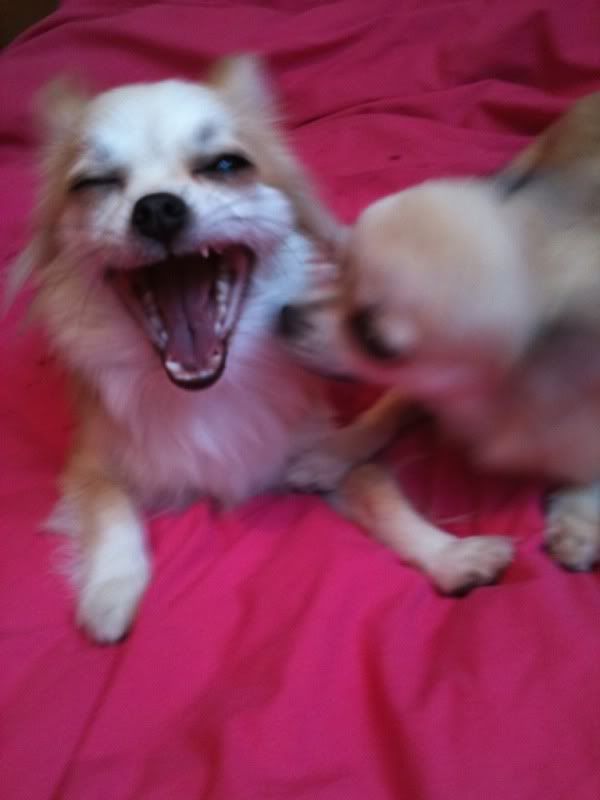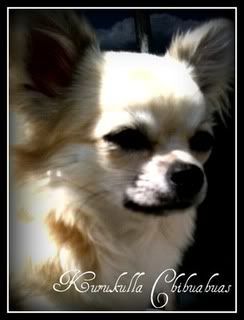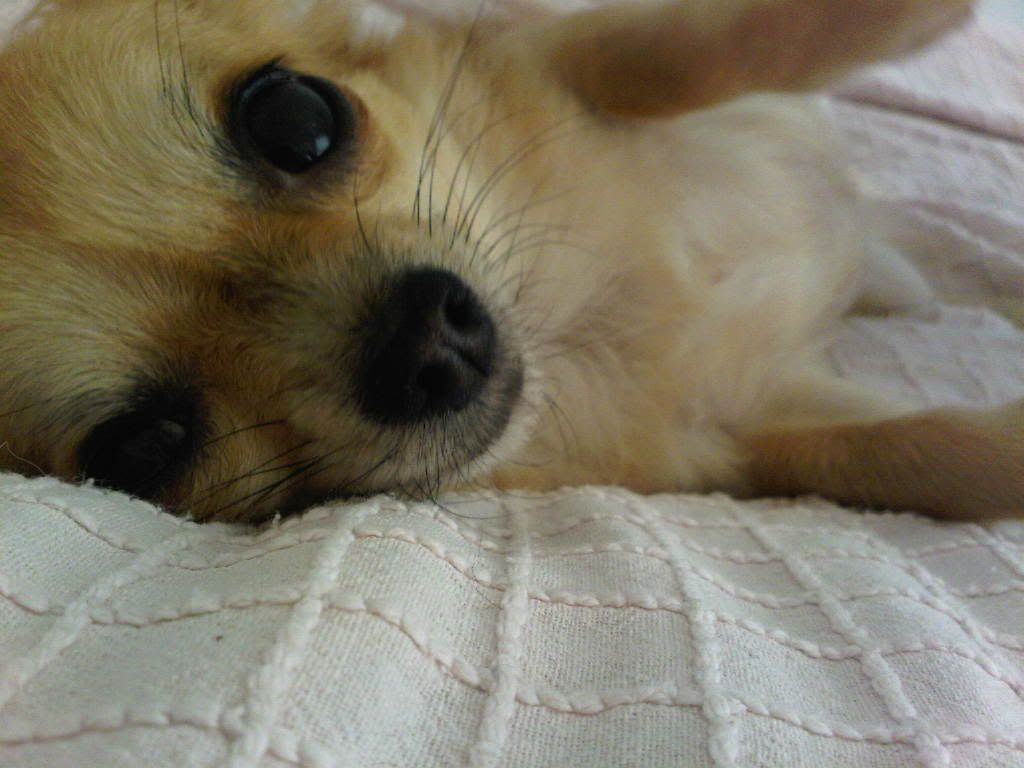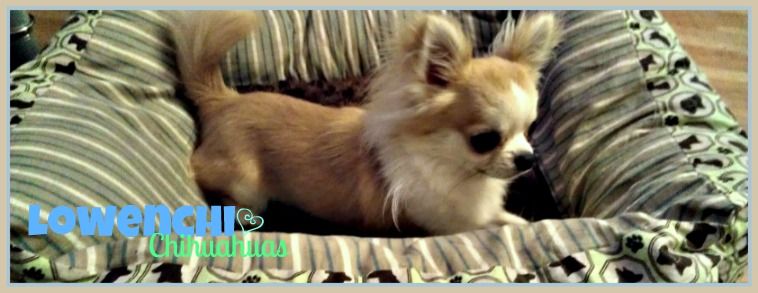|
|
Post by Sarah on Mar 30, 2011 16:21:49 GMT
Chihuahua Breed Standard - courtesy of the UK Kennel Club
www.thekennelclub.org.uk/item/182General Appearance Small, dainty, compact. Characteristics Alert little dog; swift-moving with brisk, forceful action and saucy expression. Temperament Gay, spirited and intelligent, neither snappy nor withdrawn. Head and Skull Well rounded ‘apple dome’ skull, cheeks and jaws lean, muzzle moderately short, slightly pointed. Definite stop. Eyes Large, round, but not protruding; set well apart; centre of eye is on a plane with lowest point of ear and base of stop; dark or ruby. Light eyes in light colours permissible. Ears Large, flaring, set on at an angle of approximately 45 degrees; giving breadth between ears. Tipped or broken down highly undesirable. Mouth Jaws strong, with a perfect, regular and complete scissor bite, i.e. upper teeth closely overlapping lower teeth and set square to the jaws. Neck Slightly arched, medium length. Forequarters Shoulders well laid; lean, sloping into slightly broadening support above straight forelegs, set well under chest giving freedom of movement without looseness. Body Level back. Body, from point of shoulder to rear point of croup, slightly longer than height at withers. Well sprung ribs, deep brisket. Hindquarters Muscular; hocks well let down, with good turn of stifle, well apart, turning neither in nor out. Feet Small and dainty, turning neither in nor out; toes well divided but not spread, pads cushioned, fine, strong, flexible pasterns. Neither hare- nor cat-like, nails moderately short. Tail Medium length, set high, carried up and over back (sickle tail). When moving never tucked under or curled below the topline. Furry, flattish in appearance, broadening slightly in centre and tapering to point. Gait/Movement Brisk, forceful action, neither high-stepping nor hackney; good reach without slackness in forequarters, good drive in hindquarters. Viewed from front and behind legs should move neither too close nor too wide, with no turning in or out of feet or pasterns. Topline should remain firm and level when moving. Coat Long Coat: soft texture (never coarse or harsh to touch) either flat or slightly wavy. Never tight and curly. Feathering on ears, feet and legs, pants on hindquarters, large ruff on neck desirable. Tail long and full as a plume. Smooth Coat: smooth, of soft texture, close and glossy, with undercoat and ruff permissible. Colour Any colour or mixture of colours - but never merle (dapple). Size Weight: up to 2.7 kgs (6 lbs), with 1.8 - 2.7 kgs (4 - 6 lbs) preferred. Faults Any departure from the foregoing points should be considered a fault and the seriousness with which the fault should be regarded should be in exact proportion to its degree and its effect upon the health and welfare of the dog. Note Male animals should have two apparently normal testicles fully descended into the scrotum.
|
|
|
|
Post by brodysmom on Mar 31, 2011 15:03:08 GMT
Here is the standard from AKC for comparison ......
Chihuahua Breed Standard
Toy Group
General Appearance
A graceful, alert, swift-moving compact little dog with saucy expression, and with terrier-like qualities of temperament.
Size, Proportion, Substance
Weight – A well balanced little dog not to exceed 6 pounds. Proportion – The body is off-square; hence, slightly longer when measured from point of shoulder to point of buttocks, than height at the withers. Somewhat shorter bodies are preferred in males. Disqualification – Any dog over 6 pounds in weight.
Head
A well rounded "apple dome" skull, with or without molera. Expression – Saucy. Eyes - Full, round, but not protruding, balanced, set well apart-luminous dark or luminous ruby. Light eyes in blond or white-colored dogs permissible. Blue eyes or a difference in the color of the iris in the two eyes, or two different colors within one iris should be considered a serious fault. Ears – Large, erect type ears, held more upright when alert, but flaring to the sides at a 45 degree angle when in repose, giving breadth between the ears. Stop – Well defined. When viewed in profile, it forms a near 90 degree angle where muzzle joins skull. Muzzle – Moderately short, slightly pointed. Cheeks and jaws lean. Nose – Self-colored in blond types, or black. In moles, blues, and chocolates, they are self-colored. In blond types, pink noses permissible. Bite – Level or scissors. Overshot or undershot, or any distortion of the bite or jaw, should be penalized as a serious fault. A missing tooth or two is permissible. Disqualifications – Broken down or cropped ears.
Neck, Topline, Body
Neck – Slightly arched, gracefully sloping into lean shoulders. Topline – Level. Body – Ribs rounded and well sprung (but not too much "barrel-shaped"). Tail – Moderately long, carried sickle either up or out, or in a loop over the back with tip just touching the back.
(Never tucked between legs.) Disqualifications – Docked tail, bobtail.
Forequarters
Shoulders – Lean, sloping into a slightly broadening support above straight forelegs that set well under, giving free movement at the elbows. Shoulders should be well up, giving balance and soundness, sloping into a level back (never down or low). This gives a well developed chest and strength of forequarters. Feet – A small, dainty foot with toes well split up but not spread, pads cushioned. (Neither the hare nor the cat foot.) Dewclaws may be removed. Pasterns – Strong.
Hindquarters
Muscular, with hocks well apart, neither out nor in, well let down, firm and sturdy. Angulation – Should equal that of forequarters. The feet are as in front. Dewclaws may be removed.
Coat
In the Smooth Coats, the coat should be of soft texture, close and glossy. (Heavier coats with undercoats permissible.) Coat placed well over body with ruff on neck preferred, and more scanty on head and ears. Hair on tail preferred furry. In Long Coats, the coat should be of a soft texture, either flat or slightly wavy, with undercoat preferred. Ears – Fringed. Tail – Full and long (as a plume). Feathering on feet and legs, pants on hind legs and large ruff on the neck desired and preferred. (The Chihuahua should be groomed only to create a neat appearance.) Disqualification – In Long Coats, too thin coat that resembles bareness.
Color
Any color - Solid, marked or splashed.
Gait
The Chihuahua should move swiftly with a firm, sturdy action, with good reach in front equal to the drive from the rear. From the rear, the hocks remain parallel to each other, and the foot fall of the rear legs follows directly behind that of the forelegs. The legs, both front and rear, will tend to converge slightly toward a central line of gravity as speed increases. The side view shows good, strong drive in the rear and plenty of reach in the front, with head carried high. The topline should remain firm and the backline level as the dog moves.
Temperament
Alert, projecting the ‘terrier-like’ attitudes of self importance, confidence, self-reliance.
Disqualifications
Any dog over 6 pounds in weight.
Broken down or cropped ears.
Docked tail, bobtail.
In Long Coats, too thin coat that resembles bareness.
Approved August 12, 2008
Effective October 1, 2008
|
|
|
|
Post by Lucy on Mar 31, 2011 19:19:26 GMT
I love it when they say 'saucy'. Its such an old-fashioned word.
|
|
|
|
Post by Sarah on Mar 31, 2011 19:23:59 GMT
Lotus is saucy when she ain't crapping herself!!! We are so strict in on ours tail, bite etc  |
|
|
|
Post by brodysmom on Mar 31, 2011 19:33:00 GMT
FCI standard
Chihuahua (Chihuahueño)
Origin: Mexico.
Date of Publication of the Original Valid Standard: 24.03.2006.
Utilization: Companion dog.
Classification FCI: Group 9 Companions and Toys
Section 6 Chihuahueño
Without working trial.
Brief Historical Summary: The Chihuahua is regarded as the smallest pedigree dog in the world and carries the name of the largest state of the Mexican Republic (Chihuahua). One assumes that these dogs used to live in the wild and, at the time of the Toltec civilization, were captured and domesticated by the natives. Representations of a Toy dog called « Techichi » which lived in Tula, were used as decorations on town architecture. These statues are very similar to the present day Chihuahua.
General Appearance: This dog has a compact body. Of great importance is the fact that his skull is apple-shaped and that he carries his moderately long tail very high, either curved or forming the shape of a semicircle with the tip pointing towards the loin region.
Important proportions: Length of body slightly greater than height at withers. Desired, however, is an almost square body, especially in males. In bitches, because of the function of reproduction, a slightly longer body is permitted.
Behaviour/character:Quick, alert, lively and very courageous.
Head
Cranial Region:
Skull : Well rounded apple head ( a characteristic of the breed) preferably without a fontanel although a small one is allowed.
Stop: Well marked, deep and broad as the forehead is bulging over the set-on of muzzle.
Facial Region:
Nose: Any colour permitted. Moderately short, pointing slightly upwards.
Muzzle: Short, straight seen from side, broad at set-on, tapering towards the tip.
Lips : Lean and close fitting.
Cheeks: Only slightly developed, very clean.
Jaws/Teeth: Scissor or pincer bite. Overshot, undershot, as well as any other anomaly in position of upper or lower jaw must be strictly penalized.
Eyes: Large, roundish in shape, very expressive, not protruding, perfectly dark. Light eyes permissible, but not desired.
Ears: Large, upright, widely open, broad at set-on, gradually tapering towards their slightly rounded point. In repose inclined laterally forming an angle of 45°.
Neck: Upperline slightly arched.
Length: Medium length.
Shape: Thicker in dogs than in bitches.
Skin: Without dewlap. In the long-haired variety, the presence of a neck-ruff with longer hair is highly desirable.
Body: Compact and well built.
Topline: Level.
Withers: Only slightly marked.
Back: Short and firm.
Loin: Strongly muscled.
Croup: Broad and strong; almost flat or slightly sloping.
Chest: Ribcage broad and deep, ribs well sprung. Seen from front, roomy but not exaggerated. Seen from side, reaching to elbows. Not barrel shaped.
Lower Line: Formed by a clearly tucked up belly. Slack belly is permitted but not desired.
Tail: Set on high, flat in appearance, of moderate length; broad at root, tapering gradually towards the tip. Tail carriage is an important characteristic of the breed : when the dog is moving it is carried either high in a curve or in a semicircle with tip towards the loin region, which gives balance to the body, it should never be carried between the hindlegs nor curled below the backline. The hair on the tail depends on the variety and is in harmony with the body coat. In the long haired variety, the tail coat forms a plume. Tail is pendant in repose and forms a slight hook.
Limbs
Forequarters: Forelegs straight and of good length; seen from the front, they form a straight line with the elbows. Seen from the side, they are upright.
Shoulders: Clean and moderately muscled. Good angulation between shoulder-blade and upper arm.
Elbows: Firm and fitting close to body which ensures free movement.
Pasterns: Slightly sloping, strong and flexible.
Hindquarters: Hindlegs well muscled with long bones, vertical and parallel to each other with good angulation at hip, knee and hock joints, in harmony with angulation of forequarters.
Hocks: Short with well developed Achilles’ tendons; seen from rear, they are well apart straight and vertical.
Feet: Very small and oval with toes well apart but not splayed (neither hare- nor cat-foot). Nails particularly well arched and moderately long. Pads well developed and very elastic. Dewclaws must be removed except in countries where this practice is forbidden by law.
Gait / Movement: Steps are long, springy, energetic and active with good reach and drive. Seen from rear, hind legs should move almost parallel to each other, so that the foot prints of the hind feet fit directly into those of the front feet. With increasing speed, the limbs show a tendency to converge towards the centre point of gravity (single track). Movement remains free and springy without visible effort, head raised and back firm.
Skin: Smooth and elastic all over body surface.
Coat
Hair: In this breed there are two varieties of coat.
Smooth-haired: Coat is short, lying close all over body. If there is an undercoat, the hair is somewhat longer; sparse coat on throat and belly permissible; slightly longer on neck and tail, short on face and ears. Coat is glossy and its texture is soft. Hairless dogs are not tolerated.
Long-haired: Coat should be fine and silky, smooth or slightly wavy. Not too thick undercoat desired. Coat is longer, forming feathering on ears, neck, rear of front and hind legs, on feet and on tail. Dogs with long billowing coat will not be accepted.
Colour: All colours in all possible shades and combinations are admitted.
Weight: In this breed only the weight is taken into consideration, not the height.
Weight: Ideal weight : between 1.5 and 3 kg. However, dogs between 500 gr and 1.5 kg are accepted. Subjects weighing more than 3 kg shall be disqualified.
Faults: Any departure from the foregoing points should be considered a fault and the seriousness with which the fault should be regarded should be in exact proportion to its degree.
Missing teeth.
“Double teeth” (persistence of temporary teeth).
Deformed jaws.
Pointed ears.
Short neck.
Long body.
Roach or hollow back (Lordosis or Kyphosis).
Steep croup.
Narrow chest, flat ribcage.
Tail : incorrect set-on, short or twisted.
Short limbs.
Out at elbow.
Too close behind.
Severe faults
Narrow skull
Eyes small, deep set or protruding.
Long muzzle.
Under or overshot mouth.
Patella luxation.
Eliminating faults
Aggressive or overly shy.
Deer type dogs (dogs with an atypical or extremely stylized structure: refined head, long neck, slender body, long limbs).
Dogs with a large fontanel.
Drop ear or short ear.
Extremely long body.
Absence of tail.
In the long- haired variety : Dogs with very long, fine and billowing coat.
In the smooth-haired variety : Bald patch (alopecia).
Weight over 3 kg.
Any dog clearly showing physical or behavioural abnormalities shall be disqualified.
N.B.: Male animals should have two apparently normal testicles fully descended into the scrotum.
|
|
|
|
Post by Lowenchi on Mar 31, 2011 19:37:47 GMT
I love the word saucy too, its very true tho. Especially in a over confident show dog there is no better word to describe them!
Its amazing how diffrent but alike our standards are!
|
|
|
|
Post by brodysmom on Mar 31, 2011 19:39:49 GMT
I like reading and comparing the standards too. I hadn't really read the FCI one closely - it's pretty interesting! PL is a 'serious' fault. Um.... yeah, I'd say so!!!!  |
|
|
|
Post by Lowenchi on Mar 31, 2011 19:44:29 GMT
You would be surprised how many dogs get away with LP  I'm glad were not in italy or somewhere the standard is pretty hardcore |
|














